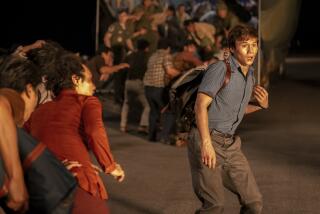MIA Kin Cite Loss of Leverage on Hanoi : Troops: The remains of a California airman were identified last month. Relatives of the missing fear end of trade embargo means he may be the last.
- Share via
WASHINGTON — On May 14, 1968, Navy Lt. (j.g.) Barry E. Karger, a native Californian, was 22 years old, piloting an A-4F aircraft over North Vietnam’s Quang Binh province when he radioed: “I’m rolling in!”
More than 25 years would pass before Karger’s fate would be known. Last month, his remains--three teeth in a fragment of his lower jaw--were dug out of a river where his plane crashed after it was shot down while he was dropping electronic sensors along the Ho Chi Minh Trail. Karger, who had been considered “missing in action/body not recovered” all these years, was now positively enrolled among the dead.
But with President Clinton’s decision Thursday to lift the trade embargo against Vietnam, many activists and family members of the 2,238 others still officially missing fear that he will be the last one positively identified. Without the embargo as leverage, they said, Vietnam will no longer feel the need to cooperate with America’s efforts to recover POW-MIAs.
“I don’t think we should do anything for Vietnam,” Karger’s sister, Sheryl Mossman of Medford, Ore., said Thursday. “I wouldn’t walk across the street for Vietnam. I wouldn’t send them a bag of flour. They have no regard for human life and, no matter what we do, it doesn’t mean anything to them.”
But in announcing his decision, Clinton pointed to several key areas in which progress has been made in resolving the POW-MIA issue and repeated his belief that the Vietnamese will continue to cooperate.
He noted that since last July, the remains of 39 American servicemen have been recovered and sent home. He said the number of “discrepancy cases”--where it is possible servicemen could have survived--has also been reduced since July, from 135 to 73.
The President said Vietnam and Laos had grown more helpful in conducting searches along their common border and continued to release documents that could help answer many of the lingering questions about missing Americans.
Military personnel working with the Hanoi government have also said that they expect Hanoi to continue working closely with American officials to open up more crash sites and to make more records available.
And they have discounted allegations by some activists that POWs are still living in Vietnam who will be killed now that they no longer serve as bargaining chips for improved business relations with the United States.
“The Vietnamese,” said Lt. Col. David Fredrikson, a spokesman for the Joint Task Force Full Accounting office in Honolulu, “already give us pretty much all that we ask for.” The task force was established to investigate cases of missing servicemen.
Fredrikson just returned from a December trip to Vietnam, where U.S. military officials worked with the Hanoi government digging up sites that might hold American remains. “The Vietnamese say they consider this a humanitarian issue, whether there’s an embargo lifted or not,” Fredrikson said. “They say they want to help American families find answers to their questions.”
To dramatize that point, he said, Vietnamese officials allowed U.S. field teams to dig through a civilian graveyard in search of American remains. He said that family members of Vietnamese interred there even allowed the American teams to dig up Vietnamese graves.
No evidence of Americans was found, he said.
But Fredrikson did not discount the possibility that Vietnam’s cooperation may have been linked to hopes that the embargo would be lifted. “There is so much economic need in that country for some of the things the Western world can provide that it obviously is on everyone’s mind,” he said.
In the three years since the Joint Task Force Full Accounting office was established, the remains of 29 individuals have been identified. But with new technological advances, officials said they hope more identifications can be made from remains now at the military laboratory in Honolulu.
They also noted that Vietnam has approved more excavations and that U.S. investigative teams are scheduled to travel there this month. “These are air crash and battle sites,” he said. “There will be a lot of digging.”
Within the year, he said, the task force expects to run out of crash sites to explore.
Fredrikson and other task force members acknowledged that it will be impossible ever to identify all the missing, particularly fliers lost over the ocean. And he said that all reports of live POWs are investigated but that so far, all have proven to be false. “There has not been anything to lead us to believe there is a live (missing serviceman) there,” he said.
The Pentagon also determined last month that a new Russian document claiming that Vietnam held 1,205 American prisoners in 1972--more than twice as many as were released a year later--was full of “inaccuracies, inconsistencies, exaggerations and fabrications.”
But ex-Green Beret J. Thomas Burch Jr., chairman of the National Vietnam Veterans Coalition in Washington, said Thursday that his group believes up to 200 Americans may still be captive in Vietnam and Laos. He said U.S. visitors to Vietnam, as well as Vietnamese, have reported seeing Americans in prison and labor camps--even in caves north of Hanoi. Without the embargo, he suggested, their lives will be endangered.
“If a few of these people suddenly now stumble out of there, the Vietnamese will be seen as liars and world opinion will flare up against them, and any new American business they’re trying to get will dry up,” Burch said. “I’m sure there are people who will want to kill them rather than take a chance that they might eventually surface.”
More to Read
Sign up for Essential California
The most important California stories and recommendations in your inbox every morning.
You may occasionally receive promotional content from the Los Angeles Times.











